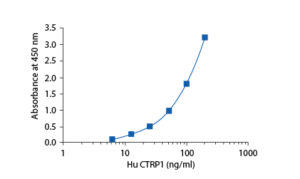CTRP1 Human ELISA
CTRP1 (Complement C1q tumor necrosis factor-related protein 1) is a member of the CTRP superfamily and is localized to human chromosome 17. It is a 32 kDa secreted glycoprotein comprised of 281 amino acids encoded by the human gene C1QTN1. This protein is a highly conserved paralogue of adiponectin, containing a cluster of collagenlike repeats, a C-terminal globular ‘C1q-like’ domain and an N-terminal signal peptide
sequence followed by a variable region and hence is predicted to be secreted protein. CTRP1 is primarily expressed from cells in the stroma vascular fraction of adipose tissue and is also specifically expressed in the zona glomerulosa of the adrenal cortex and in vascular wall tissue. This protein is ubiquitous in most regions of the human brain and is particularly abundant in the spinal cord, but the pattern of expression and functions of CTRP1 in brain are completely unknown. Expression of CTRP1 (like adiponectin) is induced by PPARg (peroxisome-proliferator-activated receptor γ). The LPS -induced increase in CTRP1 gene expression is found to be mediated by TNF-alpha and IL-1beta. Sequence homology inferred that the CTRP1 cytosolic domain is folded as a collagen-like helix followed by a globular domain. The interaction of the globular domain with the V2R was confirmed by pull-down experiments indicating that this structural motif can also interact with cytosolic proteins. Obesity and the metabolic syndrome are frequently associated with elevated levels of aldosterone and the level of CTRP1 is increased in the blood of hypertensive patients, as aldosterone production was stimulated by CTRP1. It is well known that obesity is the leading cause of hypertension. CTRP1 is stimulating aldosterone production through induction of CYP11B2 gene expression. Therefore, CTRP1 could be a molecular link between obesity and hypertension.
Areas of investigation: Energy metabolism and body weight regulation, Metabolic syndrome.
Type
Sandwich ELISA, HRP-labelled antibody
Applications
Serum, Plasma-Citrate
Sample Requirements
8 µl/well
Storage/Expiration
Store the complete kit at 2–8°C. Under these conditions, the kit is stable until the expiration date (see the label on the box).
Calibration Curve

Calibration Range
3.13–100 ng/ml
Limit of Detection
0.016 ng/ml
Intra-assay (Within-Run)
n = 8; CV = 2.7%
Inter-assay (Run-to-Run)
n = 5; CV = 8.5%
Spiking Recovery
94,90%
Dilutation Linearity
100,20%
Crossreactivity
bovine Non-detectable
cat Non-detectable
dog Non-detectable
goat Non-detectable
hamster Non-detectable
horse Non-detectable
pig Non-detectable
rabbit Non-detectable
rat Non-detectable
sheep Non-detectable
chicken Non-detectable
monkey Yes
mouse Yes
human Yes
– Bai B, Ban B, Liu Z, Zhang MM, Tan BK, Chen J. Circulating C1q complement/TNF-related protein (CTRP) 1, CTRP9, CTRP12 and CTRP13 concentrations in Type 2 diabetes mellitus: In vivo regulation by glucose. PLoS One. 2017 Feb 16;12(2):e0172271. doi: 10.1371/journal.pone.0172271
– Chalupova L, Zakovska A, Adamcova K. Development of a novel enzyme-linked immunosorbent assay (ELISA) for measurement of serum CTRP1: A pilot study: Measurement of serum CTRP1 in healthy donors and patients with metabolic syndrome. Clin Biochem. 2013 Jan;46 (1-2):73-8
– Han S, Kim JD, Lee S, Jeong AL, Park JS, Yong HJ, Boldbaatar A, Ka HI, Rhee EJ, Lee WY, Yang Y. Circulating CTRP1 Levels in Type 2 Diabetes and Their Association with FGF21. Int J Endocrinol. 2016;2016:5479627
– Pan X, Lu T, Wu F, Jin L, Zhang Y, Shi L, Li X, Lin Z. Circulating complement-C1q TNF-related protein 1 levels are increased in patients with type 2 diabetes and are associated with insulin sensitivity in Chinese subjects. PLoS One. 2014;9 (5):e94478
– Rodriguez S, Lei X, Petersen PS, Tan SY, Little HC, Wong GW. Loss of CTRP1 disrupts glucose and lipid homeostasis. Am J Physiol Endocrinol Metab. 2016 Aug 23;:ajpendo.00087.2016
– Shabani P, Naeimi Khaledi H, Beigy M, Emamgholipour S, Parvaz E, Poustchi H, Doosti M. Circulating level of CTRP1 in patients with nonalcoholic fatty liver disease (NAFLD): is it through insulin resistance?. PLoS One. 2015;10 (3):e0118650
– Xin Y, Lyu X, Wang C, Fu Y, Zhang S, Tian C, Li Q, Zhang D. Elevated circulating levels of CTRP1, a novel adipokine, in diabetic patients. Endocr J. 2014;61 (9):841-7 – Ying C, Wu Q, Wang L, Su Q, Yang J, Lu L, Zhang FR, Sun J,Xu Z. The influence of increasing serum adipose tissue hormone on chronic heart failure combined with sleep apnea syndrome. Int J Clin Exp Med . 2016 Feb;9 (2):2677-2687

